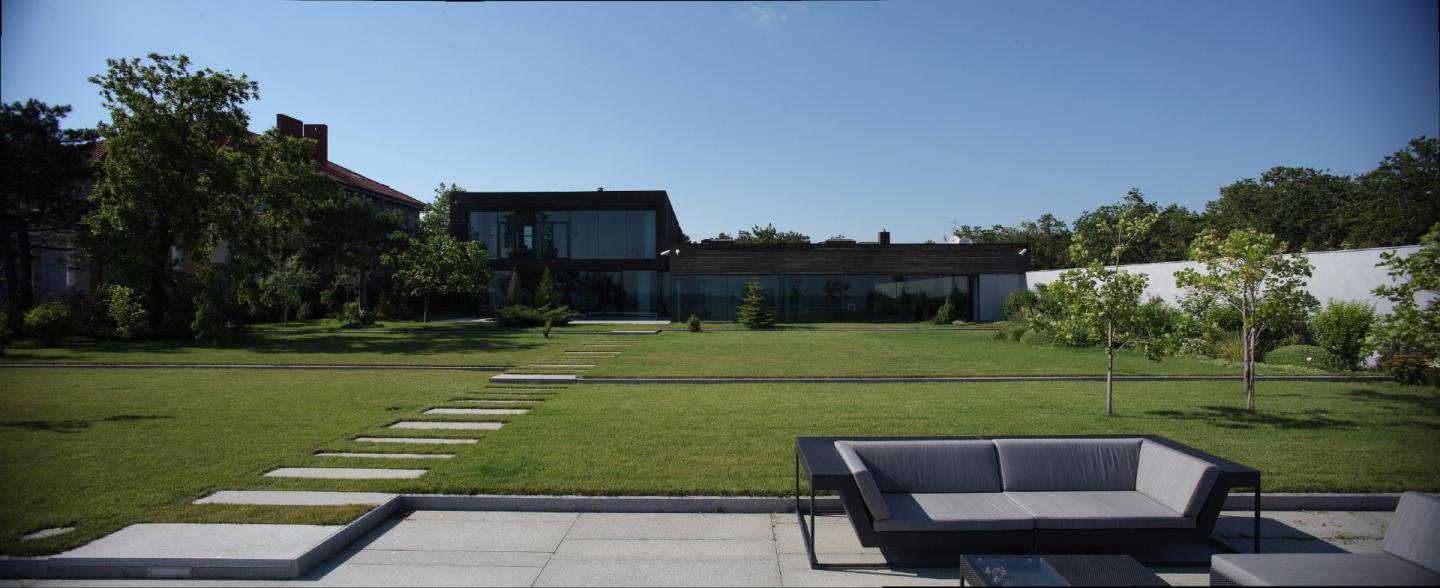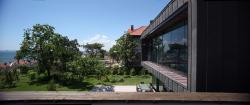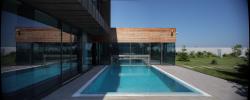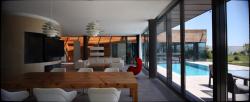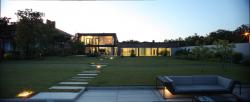The plot is situated on the edge of a steep plateau and occupies the borderline position in the row of houses. This position invited a plentiful of interpretations of open and closed spaces.
The combination of two volumes was arranged in such a way so as to allow an uninterrupted sightline between the sea and the house situated behind our plot. The location of the house itself was largely determined by the desire to preserve as many of the existing trees as possible. Another important factor was the necessity to create a harmonious interrelation between the house, the garden and the sea view. These three environments are placed each along its own line and they interact in a variety of ways, depending on the position of the observer (whether it is the garden, the house or the mirador).
The entire space opens towards the sea. In addition to the outer sea horizon, which is a typical feature of any seaside house, we introduced another water surface – that of the swimming pool, which enhances the visible proximity of the sea. The swimming pool is composed of two parts that can be separated or joined together depending on the season. Water element is the heart of the house, which explains its name: Waterpatio.
The owner of the house is a successful businessman with half-pragmatic and half-romantic personality. His grown-up children live separately, so the house has minimum isolated spaces and looks like a house for a newly-wed couple. The contrast between open and closed spaces continues in the way how the house faces the street with its closed side and opens towards the sea and the garden.
The central entrance into the house divides it into two functional blocks. The lower block contains a garage, a storage room, and the so called wellness zone, with a swimming pool, sauna and hamam. The other is the living block. The skylight in the hall makes this division even more distinctive. When entering the house one immediately understands the interrelation between different zones.
The main living space on the ground floor combines the functions of a dining room, a lounge zone and a small kitchen. The multi-purpose “island” in the middle contains audio- and visual facilities, a fireplace, a TV set, a mini-bar, air-conditioning equipment and a small library. The entire internal circulation is performed around this “island” and enables easy access to the upper floor and to the basement, which houses a gym and an indoor cinema.
On the upper floor there is a small library, two guest rooms and one spacious master bedroom. The flared space of the upper floor opens towards the sea horizon through the master bedroom and bathroom and shows a never-ending marine movie.
The garden itself is structured with the help of terraces that make it appear more spacious than it actually is. The garden is denser near the house where it serves as a protective “Mediterranean” wall.
The mirador, with its barbecue spot and a sofa, plays an important role in the entire composition. Being another strategic point alongside with the terrace near the swimming pool, it invites a different perception of the house and its surrounding.
2005
2006
Three basic materials were used in the construction of the house: Siberian larch, stucco (that looks like Venetian stucco) and copper. The latter acquired a noble tint in this coastal environment, which makes it look like rusty steel.
Oleg Drozdov, Alexander Strulev,
Landscape: Jeroen Schipper Architecten
